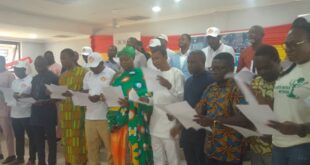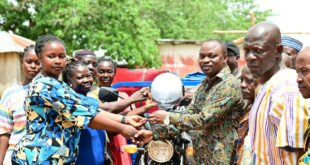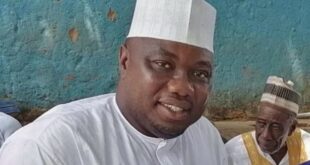Illegal small scale mining popularly referred to as Galamsey didn’t begin now, in fact, per information from the nationalgeographic.com, it can be traced to the 80’s where the Small-Scale Gold Mining Act of 1989 implemented a system for obtaining small-scale mining licenses. At the time, these small-scale miners were in groups of 9 or less, working by hand to dig, pan and washing gold.
In 2006, an updated law stipulated that only Ghanaian citizens could receive mining licenses and required permits from the country’s Environmental Protection Agency and Forestry Commission to work.
Over time, small scale mining, which has now come to be known as galamsey has become a big ‘business’ for some individuals who hire several workers to scout for gold through the most illegal means.
Pollution of Ghana’s water bodies has now become the order of the day with galamsey and yet the fight against the menace seems endless.
How can you fight an invisible enemy? How successful can this fight be when the very persons at the core of this fight have not yet been discovered?
Many suggestions have been made, accusations and allegations alike, but naming and shaming has not been a very fruitful venture as no one appears to want to cite the individuals involved in the illegal mining practice.
We take a look in this piece, at groups of people that have emerged in the conversation surrounding galamsey.
Chinese Nationals:
Activities of some Chinese nationals as regards the menace of galamsey has been prominent as a contributing factor.
On a number of occasions, some Chinese nationals have been arrested over their involvement in galamsey.
This year alone, particularly after Government’s set up of ‘Operation Halt,’ some Chinese operators have been arrested. Two in Atieku near Twifo Praso in the Central Region and others at River Pra in the Eastern Region. Some excavators were also burnt.
These are recent but casting our minds a little back, one name comes up without much effort. Asia Huang, the Chinese Galamsey Kingpin who was popularly known as Aisha in Ghana.
She was described as one of the most notorious galamsey kingpins in Ghana.
In 2016, she was arrested by National Security operatives for flouting mining laws but was released barely a week after. Her activities were said to have degraded lands, destroyed cocoa farms and polluted water bodies in several communities in the Amansie area in the Ashanti Region.
Aisha and her compatriots were arraigned again before court on May 9, 2018 and charged with three counts of undertaking small-scale mining operations contrary to Section 99 (1) of the Minerals and Mining Act, 2006 (Act 703); providing mining support services without valid registration with the Minerals Commission and the illegal employment of foreign nationals, contrary to the Immigration Act, 200 (Act 573).
In December 2018, the case involving Huang and her co-accused was discontinued by the Accra High Court after State Attorney Mercy Arthur presented the application for nolle prosequi to the Accra High Court presided over by Justice Charles Ekow Baiden. The 5 accused persons were discharged subsequently.
Aisha was deported in 2019 and the then Senior Minister, Osafo-Marfo suggested that the deportation was in exchange for the $2 billion Sinohydro Chinese deal, a claim that was later refuted by the then Lands Minister, John Peter Amewu. He stated that she was not exchanged for the loan or factored in government’s decision to secure the loan.
Chiefs:
These have been more often than not, cited as the foundation of the galamsey menace. In fact, in most places where galamsey is occurring including Tarkwa, Obuasi, Osino and Amansie, chiefs have been cited as the ones giving out their lands to these people to mine illegally.
A number of prominent chiefs have confirmed this disturbing factor over time and most recently, the Asantehene, Otumfuor Osei Tutu II added his voice.
In April 2017 for Instance, Gkyekitihene, Nana Tuaben III, while speaking to an Accra-based radio station cited the wanton sale of lands by some chiefs to galamseyers as a huge contributing factor to the growing canker.
An investigation conducted by the Bureau of National Investigations (BNI) into illegal mining activities in 2017 revealed that Chiefs and elders in towns like Adieworsu, Jumako, Abura, Tonru and Mempeasem were actively involved in galamsey.
Per the report, the Chief of Bokorkope in the Shama District of Western Region, Nana Issah Muni for instance was said to have acquired a concession from the Minerals Commission and the Shama District Assembly under the pretext of winning sand but ended up using it for illegal mining activities.
In the most recent instance, Asantehene Otumfuo Osei Tutu II, during a Regional Consultative Dialogue on Small Scale Mining in the Ashanti Region revealed that some chiefs are involved in galamsey.
According to him, some chiefs were giving out land and that had been confirmed by some culprits.
But even in this instance, just a few names have popped up. No specifics so again the question is, how does this cease?
Politicians:
Any names? Well a few but from rumours. Whilst it is for sure that there are some politicians and influential figures involved in the galamsey business, names have been left out.
A BNI Investigative report in 2017 however cited some NPP and NDC high profiled people as engaging in the menace. Names including those of one Benson Baba Tongo of the NDC, Bunyak Kolog of the NPP, CEO of Bupong Construction Limited at Twifo Praso, Prince John Baidoo were cited.
Though there were some denials, this was one out of the very few times naming and shaming was done.
In April 2017, all 275 Members of Ghana’s parliament appended their signature to a Multilateral Mining Integrated Project which is a quasi-militant campaign against illegal small scale mining.
The campaign which calls on the MPs to ‘save our lands and water bodies’ gained massive support with these MPs appending their signatures to it.
Question is, how many of these MPs are engaged in galamsey operations in the dark? National Women Organiser of the New Patriotic Party, Madam Kate Gyamfua was recently cited as being involved in galamsey. As part of government’s efforts to clamp down on the menace through the deployment of 200 military personnel, she was one of the persons whose excavators were burnt.Madam Gyamfua who is said to be Managing Director with mining firm, Xtra Gold Mining Company had 8 of her excavators burnt by the Operation Halt team. Though she says her company is law compliant, that’s just one of many cases of politicians involved in galamsey, many of which remain unknown.
Then Lands Minister, Peter Amewu undoubtedly got things working during his era at the ministry as far as the fight against illegal mining was concerned. His strategies were apt and straightforward and yielded some results. In 2017 for instance, he dismissed some 9 district mine officers of the Minerals Commission over their supposed failure to ensure effective monitoring and compliance with the mining rules and regulations.
Everyone seems to be complaining and ranting about the pollution of Ghana’s water bodies but even the policymakers seem to be getting their greed satisfied and at the cost of the ordinary Ghanaian.
Way forward?
The fight against galamsey will only be feasible if people are identified, named, shamed and punished subsequently.
The burning of excavators may work to some extent, education may work, dialogue and meetings may work but ultimately, it is only if the law works against these greedy persons who are putting their selfish interests above that of the entire country and citizens, that Ghana may be getting somewhere.
It is only then that our water bodies and rivers may see any hope of being clear. It is only then that the menace of galamsey can be really FOUGHT against.
Source: www.ghanaweb.com
 Home Of Ghana News Ghana News, Entertainment And More
Home Of Ghana News Ghana News, Entertainment And More




